by Julie McConnell | Sep 16, 2016
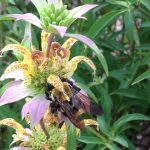
Bee visiting Monarda punctata. Photo: J. McConnell, UF/IFAS
If you are looking for a late summer blooming plant that attracts pollinators and survives in a tough spot, dotted horsemint (Monarda punctata) is for you! This native plant thrives in sunny, well-drained sites but will also tolerate moist garden spots. It grows quickly and blooms prolifically – attracting pollinators by the dozens. A plant covered in blooms is very showy and when you go in for a closer look, you’ll see unique flowers.
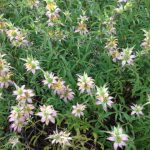
Dotted horsemint brings color to the summer garden. Photo: J. McConnell, UF/IFAS
This plant can get 3 feet tall by 4 feet wide but it is tolerant of pruning in the growing season to keep it tidy and encourage bushiness. Just be sure to prune it before it sets flowers, a good rule of thumb is to prune before the end of June.
Propagation is by division or seed. Few pests affect dotted horsemint.
To read more about this flowering perennial:
Monarda punctata Bee Balm, Horsemint
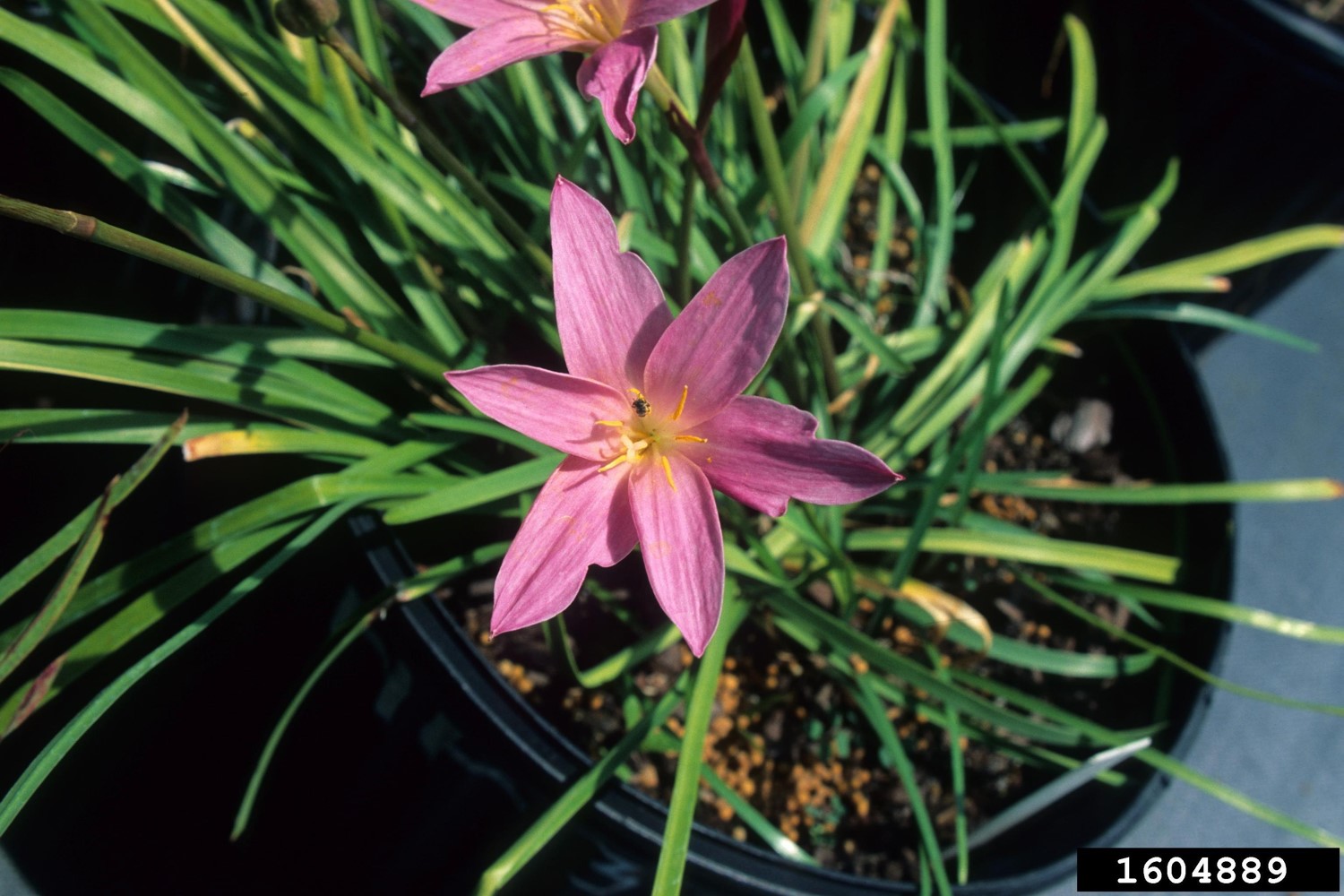
by Mary Salinas | Sep 2, 2016
Florida is home to many gorgeous and desirable native plant species. One to consider for your landscape is the rainlily, Zephyranthes and Habranthus spp. They are easy to care for and are bothered by few pests.
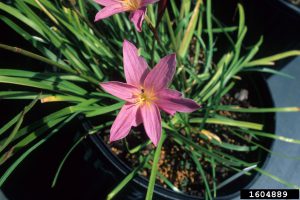
Cuban rainlily, Zephyranthes rosea. Photo: John Ruter, University of Georgia, Bugwood.org
As the name implies, rainlilies do thrive when getting consistent rain or watering. A good soaking rain event will result in blooms within a few days. This love for moisture makes them perfect for rain gardens.
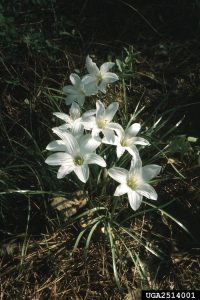
Atamasco rainlily, Zephyranthes atamasco. Photo: Jerry A. Payne, USDA Agricultural Research Service, Bugwood.org.
Plant the bulbs or transplants in full sun to part shade in moist but well-drained fertile soil. Let them be for many years in order to form large impressive clumps and that is when they flower the best. You can also separate the clumps every few years to colonize new areas and pass along to others. After the plants bloom they will reliably set seed that you can collect to start rainlilies in other parts of your garden. However, the seeds are viable for only a short time so you should plant them immediately.
For sources of plant material, try your local nursery that tends to carry native plants or through online sources.
For more information:
Rainlily, Zephyranthes and Habranthus spp.: Low Maintenance Flowering Bulbs for Florida Gardens
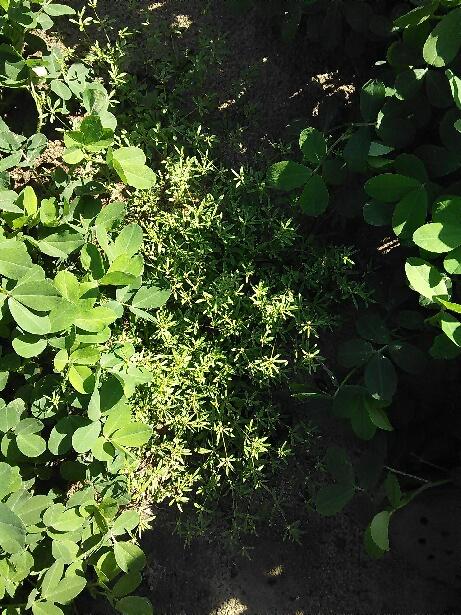
by Mark Tancig | Jul 5, 2016

When you don’t know what’s ailing your plant, ask an expert.
Many gardeners get stumped when a favorite plant of theirs comes down with a strange “something”. Many of these gardeners know about UF/IFAS Extension and call their local horticulture and agriculture agents for assistance in figuring out what’s going on. However, even these experts are often stumped by what they see. Fortunately, the agents have another layer of experts to fall back on. In addition to the resources in Gainesville, we have the Plant Disease Diagnostic Clinic, located at the North Florida Research Center in Quincy. Plant pathologists here can help determine what fungus, bacteria, virus, or viroid may be the problem.
Plant pathologists are basically plant doctors. They use all sorts of sophisticated techniques to determine what is the cause of a particular plant problem, from growing out fungal spores to examining DNA. Not only do these plant doctors tell us what the ailment is, they also provide recommended cures, or control options. They are also doing research to prevent different diseases from taking hold in our area and reduce the impact on our local growers.

Plant pathologist at work!
At a recent workshop in Quincy, we learned that plant pathology researchers are working on a fungus that affects watermelons, virus and bacteria that can wipe out a farmer’s tomato crop, and a virus that could impact our local roses. Working as a team of scientists, they study these pathogens in the lab and conduct controlled field experiments to figure out which techniques are most effective. Some of this research is leading to different methods and/or products that can help growers and gardeners alike keep their fields and landscapes healthy.
So, if your plants have problems, please contact your local Extension Office. If they don’t know the answer, then the network of scientists, including plant pathologists, in the UF/IFAS Extension family can be called on for backup to provide you with the best possible answer.

by Molly Jameson | Jun 8, 2016
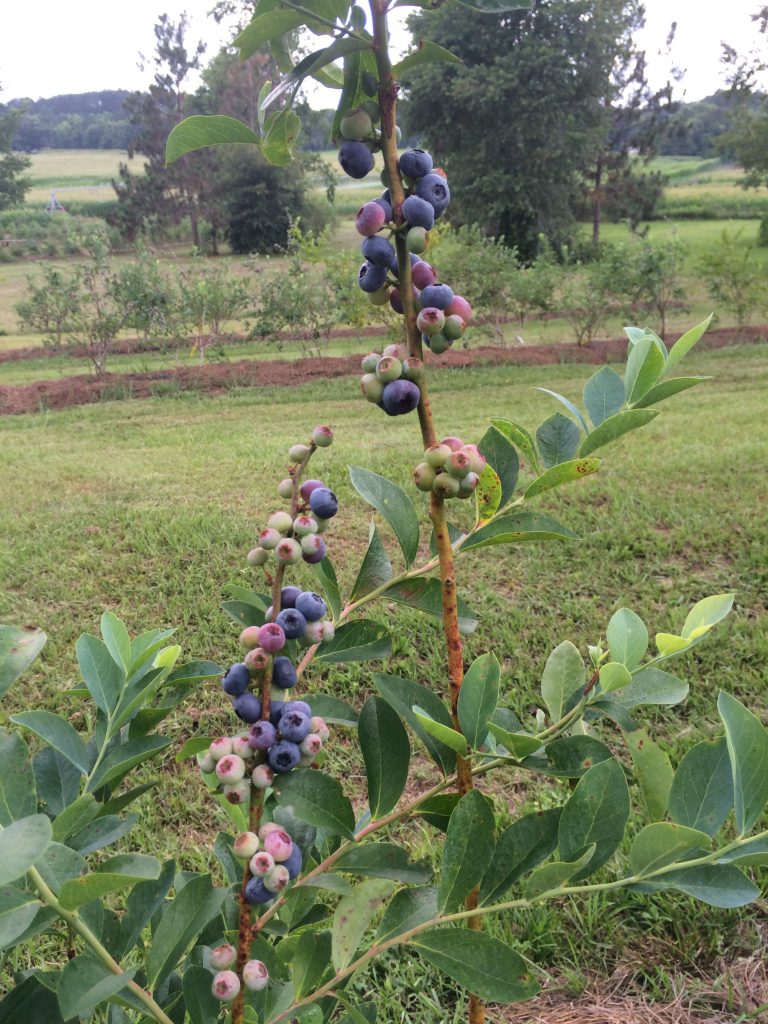
Blueberries beginning to ripen at Blue Sky Berry Farm. Photo by Molly Jameson.
There is something almost magical about picking vibrantly blue blueberries off a bush and eating them fresh. If you watch the blueberries develop, you see them go from shades of pale green and blush red to dark and puffy and bright blue. When a blueberry is ready – you know it!
Blueberries are one of the few crop plants that are actually native to eastern North America. The most popular types are the rabbiteye blueberry (Vaccinium ashei) and the highbush blueberry (Vaccinium corymbosum). Both can be found in northern Florida and southern Georgia, and the highbush blueberry can be found as far north as southeastern Canada. There are at least eight other Vaccinium wild blueberry species that can be found in the woods and near swamps in Florida. They are usually smaller and don’t taste quite as sweet as the rabbiteye and highbush, but birds rely on them heavily for forage.
If you’ve never experienced a fresh blueberry right off the bush, then you may want to consider either foraging for wild blueberries, growing your own, or scouting out a local u-pick blueberry farm near you.
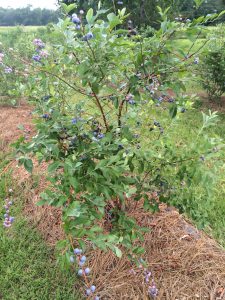
Mulch blueberries with pine straw. Photo by Molly Jameson.
Let’s first consider the joys of growing your own. Blueberries require an acidic soil pH, between about 4.0 and 5.5. Lucky for most of us in the Panhandle, our soil pH is largely naturally acidic. If you have pine trees growing in your area, you most likely can grow blueberries. And the pine straw makes an excellent blueberry mulch! There are many rabbiteye cultivars that have been specifically developed to grow well in our hot climate – requiring fewer “chilling hours” than their northern counterparts. Check out varieties such as Powderblue, Brightwell, Tifblue, and Climax. Highbush blueberries can also do well in northern Florida, although they tend to flower early, making them susceptible to late freezes. Try highbush varieties such as Bluecrisp, Emerald, and Star. Each has its own advantages and drawbacks, such as fruit cracking and insect susceptibility. Click here to learn more about growing blueberries in Florida.
If you are not already growing blueberries, and you want fresh blueberries, then be sure to check out a local u-pick near you. This year you may have noticed we had a warm winter, which delayed the onset of blueberry dormancy. This means the crop is hitting its peak about two or three weeks later than normal. But don’t delay – blueberry season in north Florida typically declines by the beginning of July, so the season is upon us!
If you are in the east Panhandle, be sure to check out u-pick operations such as Blue Sky Berry Farm, Myrtle Creek Farm, Green Meadows Farm, and Blueberry Springs Farm.
Blue Sky Berry Farm, which is located just three miles south of the courthouse in Monticello, on 1180 Ashville Highway, is entering its second season as a u-pick, and its bushes have really grown! They use organic fertilizer and grow using sustainable farming methods. Blue Sky Berry Farm anticipates being open Saturdays and Sundays from 8 a.m. to 1 p.m. this summer, but anyone interested in picking blueberries should first check the Blue Sky Berry Farm website (http://www.bskyfarm.com), as it is updated regularly during the season.
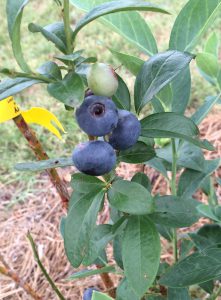
‘Titan’ blueberries at Blue Sky Berry Farm. Photo by Molly Jameson.
Green Meadows Farm, located at 177 East Bluebird Road in Monticello, is five acres of USDA certified organic blueberries. The farm is located among the trees and has been designated a Certified Wildlife Habitat by the National Wildlife Federation. It is open Fridays and Saturdays from 7:30 a.m. to noon and 5:00 p.m. to dusk, and Tuesdays from 7:30 a.m. to noon, while the blueberries last.
Myrtle Creek Farm, located at 2184 Tram Road in Monticello, has beautiful blueberry fields that are dappled with shade in the late afternoon and early evening. They currently have u-pick blueberries and blackberries available. They are open during the weekdays and weekends while the blueberries last, but do call ahead (850-997-0533) to check on availability.
Blueberry Springs Farm is located at 383 Wacissa Springs Road in Monticello, and is celebrating their 25th anniversary of harvesting blueberries. They first planted in December of 1991 and had their first harvest in June of 1991. They are open Tuesdays through Sundays 7:00 a.m. to noon and 5:00 p.m. to 7:00 p.m. You can contact Blueberry Springs Farm at (850) 997-1238 for updates, pricing, and directions.
Also check out the Florida Blueberry Growers Association website and the Florida Department of Agriculture and Consumer Services u-pick locator to discover u-picks around the state, including grape and blackberry u-picks.
Whether you are foraging for wild blueberries, picking your own blueberries, or visiting a u-pick, be sure to bring along plenty of water, a hat, close-toed shoes, and sunscreen, as blueberry season can be a very hot and sunny time of year! But once you’ve experienced your first taste of hand-picked Florida blueberries, you will be hooked and coming back for more each and every summer!
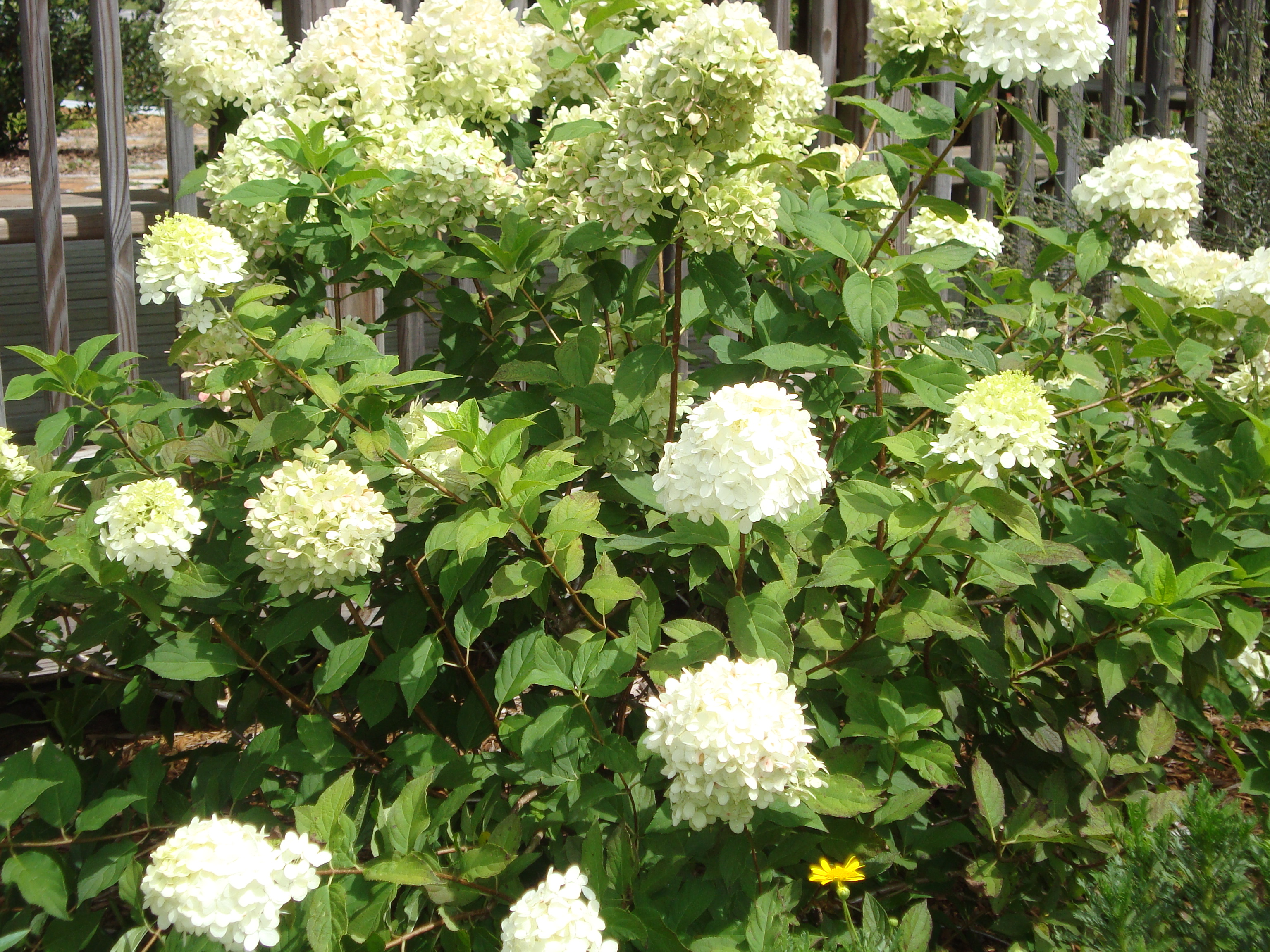
by Beth Bolles | Jun 8, 2016
Gardeners love to share plants. My yard, like many of my gardener friends, is filled with plant gifts that were started from a cutting or division of a favorite plant. These two methods of growing new plants is fairly easy once you learn the techniques and allows gardeners a way to save a little money and grow more plants for their yard, special community projects, or even some fundraising events.
In our enthusiasm over a favorite plant, gardeners must be aware that we are not allowed to propagate certain plants from cuttings or division. Many of our ornamental plants, especially newer introductions are patented plants. These are seen as ‘premium’ plants that will hopefully be in demand by the public. The plant developer or nursery invests in the patent in hopes that the plant will become the next must have ornamental. Only businesses or individuals with authorization from the patent holder are able to asexual propagate these plants since the Plant Patent Act protects these new varieties for 20 years from the date of introduction.
So if you bought a beautiful Limelight hydrangea (Hydrangea paniculata ‘Limelight’ Plant patent #12,874) for your yard, you may not take a cutting to start a new plant, even if it is only for yourself.
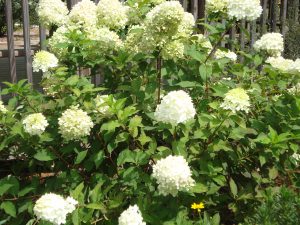
If you want more than one Limelight Hydrangea, you must purchase it. Photo by Beth Bolles
When you visit the nursery, look on the plant label which will often indicate if the plant is patented. You may also look online to see if plant has a patent.
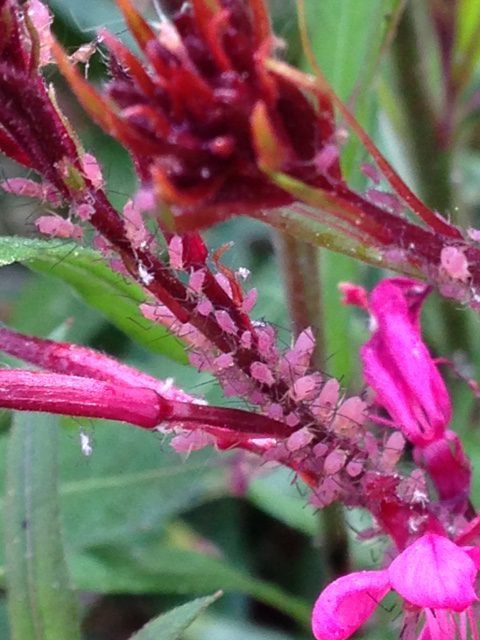
by Julie McConnell | May 5, 2016

Aphids (Macrosiphum gaurae) feeding on gaura. Photo: Julie McConnell, UF/IFAS
Every day, if I get home before the sun goes down, I like to walk around my garden and see how things are growing. At this time of year there are always new surprises in the garden – plants leafing out after a winter break, new flower buds and blooms, and of course sometimes garden pests.
My daughter and I collected some flowers last weekend and after they sat on the table for a few minutes I noticed pink bugs crawling around on the gaura stems. On further inspection I realized the stem was covered in aphids which made me go out to look at the entire plant. I found a prolific population
of aphids on the gaura and also lady beetle larvae hunting and eating the aphids! Instead of mixing up a bottle of insecticidal soap I decided to let the lady beetles do their job and just monitor the situation.
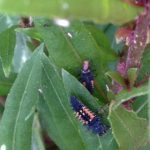
Multicolored Asian Lady Beetle Larvae feeding on aphids. Photo: Julie McConnell, UF/IFAS
Five days later I went to show my example of natural biological control to a visiting friend and we could not find a single aphid on my plant. This may not be the typical response, usually I see some level of both predator and prey but in this instance the lady beetle did a fantastic job of controlling the aphids.
So, did they eat every last one? Probably not, they likely ate many of them and the others left the plant because the predator pressure was too great. However, either scenario saved my plant from severe damage which was the overall goal.

















